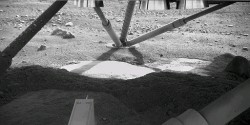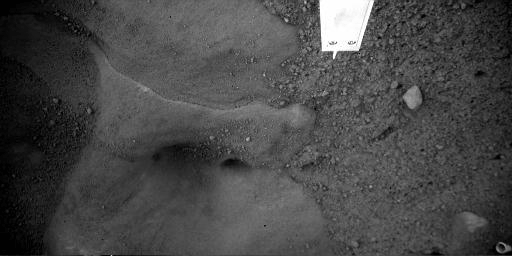[/caption]
The bright, hard surface feature beneath the Phoenix Mars Lander has visibly changed from when it was first imaged shortly after the lander touched down on the Red Planet. Scientists believe the area, called “Snow Queen” could possibly be ice. Thruster exhaust blew away surface soil covering Snow Queen as Phoenix landed, exposing a hard layer with several smooth, rounded cavities. Phoenix’s Robotic Arm Camera (RAC) took its first close-up image of the area under the lander on May 31, the sixth sol of the mission. Now, more than 60 days since landing, cracks as long as 10 centimeters, or about four inches, have appeared in Snow Queen. A seven-millimeter (less than one-third inch) pebble or clod not seen there before has popped up on the surface, and some smooth texture has subtly roughened. These changes have been occurring slowly. “Images taken since landing showed these fractures didn’t form in the first 20 sols of the mission,” Phoenix co-investigator Mike Mellon of the University of Colorado, Boulder, said. “We might expect to see additional changes in the next 20 sols.”
Mellon said long-term monitoring of Snow Queen and other icy soil cleared by Phoenix landing and trenching operations is unprecedented for science. It’s the first chance to see visible changes in Martian ice at a place where temperatures are cold enough that the ice doesn’t immediately sublimate, or vaporize, away. Phoenix scientists discovered that centimeter-sized chunks of ice scraped up in the Dodo-Goldilocks trench lasted several days before vanishing.
“I’ve made a list of hypotheses about what could be forming cracks in Snow Queen, and there are difficulties with all of them,” Mellon said.
One possibility is that temperature changes over many sols, or Martian days, have expanded and contracted the surface enough to create stress cracks. It would take a fairly rapid temperature change to form fractures like this in ice, Mellon said.
Another possibility is the exposed layer has undergone a phase change that has caused it to shrink. An example of a phase change could be a hydrated salt losing its water after days of surface exposure, causing the hard layer to shrink and crack. “I don’t think that’s the best explanation because dehydration of salt would first form a thin rind and finer cracks,” Mellon said.

“Another possibility is that these fractures were already there, and they appeared because ice sublimed off the surface and revealed them,” he said.
As for the small pebble that popped up on Snow Queen after 21 sols — it might be a piece that broke free from the original surface or it might be a piece that fell down from somewhere else. “We have to study the shadows a little more to understand what’s happening,” Mellon said.
Meanwhile, scientists and engineers for the mission are studying the icy soil on Mars, examining how it interacts with the scoop on the lander’s robotic arm, trying different techniques to deliver a sample to the TEGA or Thermal and Evolved Gas Analyzer instrument.
“It has really been a science experiment just learning how to interact with the icy soil on Mars — how it reacts with the scoop, its stickiness, whether it’s better to have it in the shade or the sunlight,” said Phoenix Principal Investigator Peter Smith of the University of Arizona.
Last weekend, the team tried two different methods to pick up and deliver a sample of icy soil to one of the ovens in TEGA. In both cases, most of the sample stuck inside the lander’s scoop, with only a small amount of soil getting into the oven. All the data received from the lander – both images and other data — indicated that not enough soil had been funneled into the oven to prompt the oven to close and begins its analysis.
The team plans to keep gaining experience in handling the icy soil while continuing with other Phoenix studies of the soil and the atmosphere.
Smith said, “While we continue with determining the best way to get an icy sample, we intend to proceed with analyzing dry samples that we already know how to deliver. We are going to move forward with a dry soil sample.”
Original News Source: Phoenix News site


Interesting, once thing crossed my mind, could someone “in the know” detail the differences between Viking & Phoenix missions?
I know TEGA goes up to 1000degrees instead of viking’s 500 but apart from that?
Thanks for not turning this question into a pro/con phoenix thing!
Perhaps the lander itself caused the cracks when it landed or the gradual stress of its weight on the surface has caused the stress cracks.
Just thought I would throw that out there since its never anything we have done.
I appreciate none of this is as “simple” as it looks, but it is frustrating to me that a machine built to find proof of water on Mars seems to be looking at ice, and they (to my knowledge) have not absolutely confirmed this…it even seems unlikely to me that it would have been so close to the surface, and still we don’t KNOW…arg!
That thing in the bottom right corner looks really strange. Is that something that came from the lander?
The lander itself may have caused the cracks. It’s had to vibrate to get soil into it’s oven, right? Couldn’t that cause them?
You can crack a glass pane with a torch. I think I’ve heard extra cold ice cubes crack as they decend into room temp liquid. So, could heat from the thruster exhaust have cracked a brittle, icy solid below the lander? Could slow paced sublimation have eventually exposed those cracks? Thanks for the puzzle. Keep them comming.
Very interesting – that little ring spanner like object in the right hand bottom corner is going to have to be identified or we’ll all go nuts. (Now, now, who said it was s.a.e Martian?)
Also, almost in the middle of the same image is a little pebble that is moving left and right with the reciprocating image whilst the whole image is moving back and forward. Could it be falling into the hole from somewhere.
David
I found it curious that little attention was given to the Martian winds and their impact on newly uncovered ice sublimation. One particular article discusses quite turbulent temperature changes in the thin surface air.
http://www.space.com/scienceastronomy/martian_winds_040213.html
To me, the pebble rolling down hill shows that something wet/tacky is drying and loosing its grip to gravity.
Interesting… It looked like shadows to me. Both of the “popped up” pebbles, and the cracks, from one picture to the next, looks like they were always there. The shadows seemed to have moved. The brighter pic. seems to have washed out the features, the darker seems to have revealed them. Just my observation. But, I’m no rocket scientist… Phoenix and its support staff are awesome!
What about the moving pebble / living organism that moves in the centre of the picture.
News tonight that water has been truly identified on Mars. So that’s one definite after all these years. Charles Ray, back in the ’50s, said that Mars once had oceans and that earth would also evolve to that stage.
[Wish we could see all of what looks like a ring-spanner].
*gasp* is it sinking?
~~~Charles Ray, back in the ’50s, said that Mars once had oceans and that earth would also evolve to that stage.~~~
Right. But instead of being cold and desolate, Earth will become extremely hot. Any water and other surface objects will effectively be boiled and burned away. It won’t happen in an instant, but in time with the Sun as it grows weaker and hotter.
Earth went thru a cold cycle, as theorized in the “Snowball Earth” cycle. The whole planet, if the theory is correct, was completely encased in ice and snow.
Either something catastrophic happened to Mars that blew most of it’s atmosphere away or it never had much of an atmosphere to begin with that would help it retain heat. I tend to lean toward the first belief. There are too many features on that planet to have been shaped only by wind erosion, meteors and/or asteroids and volcanism. Volcanism has been dormant on Mars, as far as we can figure, for eons. So if the planet itself is brutally cold, has no habitable atmosphere, and doesn’t seem to have much going on beneath it’s surface, could it really be a place to go in the event that Earth becomes inhabitable?
– Eric Near Buffalo – Earth has probably been through many temperature cycles, but I think Mars has been through the same and more. Venus could well be going through cycles that Mars and earth have already been through. However, that’s what Genesis Continuous is all about.
Sure, there will be variations, for instance, because of impacts from various sized meteorites, and Mars is much closer to the asteroid belt than we are, so probably is more vulnerable. But when it’s all boiled down, science is finding similarities in composition between earth and Mars. I remember how surprised they were to find andesite. If life did exist on Mars, as I think it did, that was 2 to 3 billion years ago. Chances of finding fossil remains? Not good, because over that period of time and the lack of atmosphere, impactive material may have covered most of those remains over.
David
OK those are my thoughts on the matter. Go to my website to see why I say what I say.